|
Page < 1 2 3 4 5 6 7 8 9 10 11 12 13 14 15 16 17 18 19 20 21 22 23 24 25 >
Show
in alphabetical order
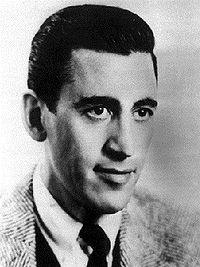 461.
J
D (Jerome David) Salinger
(1919-2010), born to a Polish Jew
and in New York, an American novelist and short story writer, best known as the
author of
The Catcher in the Rye was
regarded by many as a Hindu. Although he was an experimenter in spirituality, he
had deep respect for Hinduism and yoga, and also well versed in the Advaita
Vedanta philosophy. 461.
J
D (Jerome David) Salinger
(1919-2010), born to a Polish Jew
and in New York, an American novelist and short story writer, best known as the
author of
The Catcher in the Rye was
regarded by many as a Hindu. Although he was an experimenter in spirituality, he
had deep respect for Hinduism and yoga, and also well versed in the Advaita
Vedanta philosophy.
Salinger was a Jewish Catholic by birth, but as an adult did not follow any of
these family faiths.
Like Somerset Maugham of
The Razor's Edge
and Herman Hesse (Siddhartha
and others), his fiction drew explicitly from Eastern spirituality.
A determined seeker and a practitioner of the spiritual arts, Salinger studied
Zen after his traumatic service in World War II, and segued to the Vedanta
philosophy of Hinduism in the early 50s after publishing
The Catcher
in the Rye, that masterpiece of youthful yearning for higher
meaning. He was a regular at the Ramakrishna-Vivekananda Center on Manhattan's
Upper East Side, where the great mythologist Joseph Campbell also learned
important lessons early in his scholarly career.
He was highly influenced by
Sri Ramakrishna Paramahamsa's explanation of
Advaita Vedanta Hinduism advocating various Hindu beliefs with emphasis on
karma, reincarnation, celibacy for the seekers truth and enlightenment, and
detachment from worldliness.
The Influence of
Vedanta
and
Bhagavad Gita
in Salinger's Works:
Being a life long student of Advaita Vedanta, Salinger was profoundly influenced
by this monistic or non-dualistic system, and all these tenets and religious
studies began showing up in his short stories in the early 1950s. For instance,
the story "Teddy" has Vedantic insights expressed through a ten-year-old child.
His reading of
Swami
Vivekananda,
Ramakrishna's disciple, is seen in the story "Hapworth 16, 1924", where the
protagonist Seymour Glass describes the Hindu monk as "one of the most exciting,
original and best-equipped giants of this century." Salinger scholar Sam P.
Ranchan's study entitled An Adventure in Vedanta: J.D. Salinger's the Glass
Family (1990) throws light on the
strong
Hindu undercurrents that flow
through Salinger's later works.
For some literary critics, Franny and Zooey was a strong, emotional, human,
easily understood version of Hinduism's The
Bhagavad Gita.
Salinger became particularly attracted to Hinduism after reading
Swami Nikhilananda
and Joseph Campbell's translation of
The Gospels
of Sri Ramakrishna,
a profound insight into the various facets of life as described by the Hindu
mystic.
Salinger's daughter
Margaret wrote in her memoir Dream Catcher
that it is her belief that her parents were married and that she was born
because her father had read Paramahansa Yogananda's
guru Lahiri Mahasaya teachings that
enlighten the path of the householder, a family man.
Salinger, who passed away
on January 28, 2010 at the age of 91, perhaps wished his body cremated, almost
like Hindus do in Varanasi, rather than
buried under a tombstone. He said, "Boy, when you're dead, they really fix
you up. I hope to hell when I do die somebody has sense enough to just dump me
in the river or something. Anything except sticking me in a goddam cemetery.
People coming and putting a bunch of flowers on your stomach on Sunday, and all
that crap. Who wants flowers when you're dead? Nobody." Sadly, Salinger's
epitaph won't have any mention of this wish!
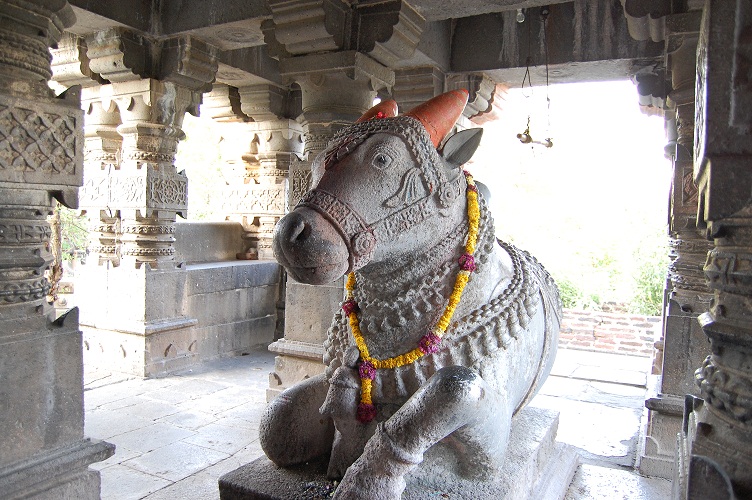
A Majestic stone Nandi - Shri.ChangaWateshwar Shiva Temple
in Saswad, Maharashtra built during the Yadav Era.
To a Hindu, God is that omnipotent, omnipresent and immanent Presence in the
universe - so transcends mere mortal minds.
God is visualized and worshiped as formless and with form.
Hinduism believes that one may view the Infinite (God) as a diamond of
innumerable facets, of which one facet may beckon an individual believer more
forcibly than the others.
(image source:
webmaster's own collection of photos taken during a recent visit).
***
(source:
J
D Salinger's Hindu Beliefs - By Subhamoy Das - about.com and
JD Salinger & Hinduism
and
A Tribute To Swami Salinger
- By Philip Goldberg).
 462.
Julia Roberts
(1967 - ) is an American actress. She became a
Hollywood star after headlining the 1990 romantic comedy Pretty Woman movie.
The American actress grew up in Georgia, the US's famous 'bible belt' and was
born to a Catholic mother and Baptist father. Roberts, who recently converted to
Hinduism, says she took up the religion because she was intrigued by it. 462.
Julia Roberts
(1967 - ) is an American actress. She became a
Hollywood star after headlining the 1990 romantic comedy Pretty Woman movie.
The American actress grew up in Georgia, the US's famous 'bible belt' and was
born to a Catholic mother and Baptist father. Roberts, who recently converted to
Hinduism, says she took up the religion because she was intrigued by it.
The 43-year-old beauty, who recently revealed she was a convert to Hinduism,
confesses she has become interested in the spirituality of the faith because it
is more than a “mere religion.”
She told The Times of India:
“Ever since I
developed my liking and fondness for Hinduism, I have been attracted and deeply
fascinated by many facets of the multi dimensional Hinduism… spirituality in it
transcends many barriers of mere religion.”
Academy Award winning Hollywood actor Julia Roberts, who recently converted to
Hinduism, reconfirmed her faith in Hinduism while commenting that her
"opting
for Hinduism is not a religious gimmick". Roberts said: "It is similar to Patsy
of Razor's Edge by
Somerset Maugham. We share a common aspect of finding peace
and tranquility of mind in Hinduism, one of the oldest and respected religions
of civilization".
Clarifying that actual spiritual satisfaction was the real reason behind her
converting to Hinduism, Julia Roberts said: "I have no intention of demeaning
any other religion simply because of my fondness for Hinduism. I don't believe
in comparing religions or human beings. A comparison is a very mean thing to do.
I have received real spiritual satisfaction through Hinduism."
According to reports, Roberts has been interested in yoga for quite some time.
She was in Haryana (India) in September last to shoot “Eat, Pray, Love” in an
ashram (retreat).
The entire Roberts-Moder family, she reveals, goes to temple together to “chant
and pray and celebrate. I’m definitely a practicing Hindu."
Julia
Roberts thinks the world should celebrate
Diwali. The ‘Eat Pray Love’ actress
believes the Hindu ‘Festival of Lights’ should be celebrated throughout the
world because it celebrates “humanity, peace and prosperity.”
She said: “Diwali should be celebrated unanimously throughout the world as a
gesture of goodwill. It not only belongs to Hinduism but is universal in nature
and in its essence too. Diwali ignites the values of self-confidence, love for
humanity, peace, prosperity and above all eternity which goes beyond all mortal
factors.”
(source:
Julia Roberts converts to Hinduism
and
Julia Roberts says “The World Should Celebrate Diwali” - Hinduism Today
Press International).
 463.
Jagadguru
Chandrashekarendra Saraswati Swamigal
(1894 - 1994)
or the Sage of Kanchi
was the 68th Jagadguru in
the Kanchi Kamakoti Peetam. He is usually referred to as
Paramacharya
or MahaSwami or Maha Periyavaal.
Periyava's charm invited the rich
and the poor, the old and the young alike to be his devotees. 463.
Jagadguru
Chandrashekarendra Saraswati Swamigal
(1894 - 1994)
or the Sage of Kanchi
was the 68th Jagadguru in
the Kanchi Kamakoti Peetam. He is usually referred to as
Paramacharya
or MahaSwami or Maha Periyavaal.
Periyava's charm invited the rich
and the poor, the old and the young alike to be his devotees.
Some of his famous
devotees include, their highness the King and Queen of Nepal,
the Queen Mother
of Greece, the Dalai Lama, M. S. Subbulakshmi, Indira Gandhi, R. Venkatraman and
Atal Bihari Vajpayee among others.
In his book
Hindu
Dharma: The Universal way of Life,
he notes:
"One
big difference between Hinduism and other faiths is that it does not proclaim
that it alone shows the path to liberation. Our Vedic religion alone has not
practiced conversion and the reason for it is that our forefathers were well
aware that all religions are nothing but different paths to realise the one and
only Paramatman."
The
Vedas proclaim: "The
wise speak of the One Truth by different names."
Sri
Krsna says in the
Bhagavad Gita: "In whatever way or form a man worships
me, I increase his faith and make him firm and steady in that worship."
And says one of the
Azhvars: "Avaravar tamatamadu
tarivari vahaivahai avaravar
iraiyavar".
"This is the
reason why the Hindus have not practiced- like adherents
of other religions-
proselytisation
and religious persecution. Nor have they
waged anything like the
crusades
or
jehads."
"That the
one and only Paramatman who has neither a form nor attributes is manifested as
different forms with attributes is another special feature of our religion.
We
worship idols representing these forms of deities. For this reason others label
us polytheists. There view is utterly wrong. Because we worship the one God, the
one reality, in many different forms it does not mean that we believe in many
gods. It is equally
absurd to call us idolaters who hold that the idol
we worship is God. Hindus with a proper understanding of their religion do not
think that the idol alone is God. The idol is meant for the worshipper to offer
one-pointed devotion and he adores it with the conviction that the Lord who is
present everywhere is present in it also. We see that practitioners of other
religions also have symbols for worship and meditation. So it is wholly unjust
to believe that Hindus alone worship idols- to regard them with scorn as
idolaters is not right."
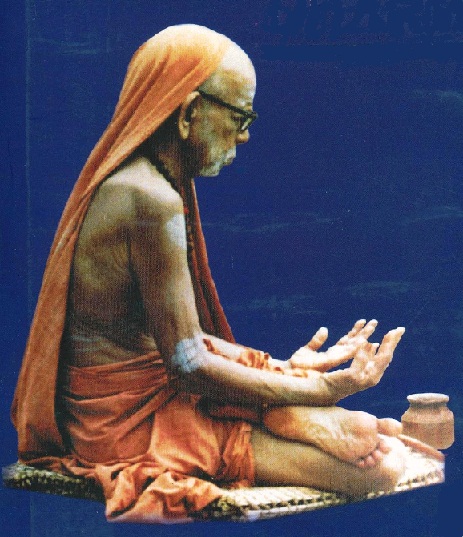
Jagadguru
Chandrashekarendra Saraswati Swamigal (1894 - 1994) or the Sage of Kanchi
Hinduism is the only religion that does not proclaim that its followers have an
exclusive right to salvation is a matter of pride for us Hindus. Our catholic
outlook is revealed in our scriptures which declare that whatever the religious
path followed by people they will finally attain the same Paramatman (God).
The key point of differentiation between Hinduism and these other faiths is not
polytheism vs. monotheism. The key differentiation is that "Hinduism" is Open
Source and most other faiths are Closed Source."
(image source:
Hindu
Dharma: The Universal way of Life - By
Chandrasekharendra
Saraswati).
***
"Christianity
has it that, if a man does not follow the teachings of Jesus Christ, he shall be
condemned to hell.
Islam says the same about
those who do not follow the teachings of the Prophet Mohammed."
We must not be angry with the
adherents of either religion on that score. Let us take it that Christians and
Muslims alike believe that followers of other religions do not have the same
sense of fulfillment as they have. So let us presume that it is with good
intentions that they want to bring others into their fold (Christianity or Islam
as the case may be) out of a desire to help them.
The
question arises as to whether God is so merciless as to keep dispatching people
for ages together to the hell from which there is no escape. Were he
compassionate would he not have sent, during all this time, a messenger of his
or a teacher to show humanity the way to liberation? Why should we worship a God
who has no mercy? Or for that matter, why should there be any
religion at all? "
"That ours is the only religion that does not proclaim that its followers have
an exclusive right to salvation is a matter of pride for us Hindus. Our catholic
outlook is revealed in our scriptures which declare that whatever the religious
path followed by people they will finally attain the same Paramatman. That is
why there is no place for conversion in Hinduism."
(source: Hindu
Dharma: The Universal way of Life - By
Chandrasekharendra
Saraswati p.
36 - 43).
No beginning - no
authorship
"The Vedas
are called Anaaadi i.e. withou a
beginning in terms of time. This means it has existed at all times. By
definition, the Vedas are 'Apourusheya' or non-human origin. The Rishis
recognized the mantras already in existence and made them known to the world.
The mantras had existed always. Since the rishis discovered them, their names
are associated with the mantras. Therefore credit is due to the rishis for
having brought the already existing but till then unknown Vedamantras to the
knowledge of men. We therefore bow to their memory by touching our head when
mentioning their name. This is a gesture in recognition of their great service.
We acknowledge it by mentioning their name before the recital of the mantra.
"Brihadharanyaka
Upanishad (2.4.10) says that the Veda in the Rig, Yajur, Sama and
Atharva forms are Iswara's breath. Nishwasitam
is the word used denoting exhalation of breath. Can we exist without breathing?
Likewise, the Vedas are the life breath, as it were, of
the Paramaatma or the Supreme Self.
If the Paramaatma who has no beginning in time exists forever (without any end
in time), then the Vedas as his life breath, are naturally anaadi, as they
coexist with Him or it."
(source:
The Vedas -
By
Chandrasekharendra
Saraswati p.
1 -6).
 464. Alexander
Gorbovsky (1930
- 2003) an expert at the
Russian
Munitions Agency
has written about India's grand Epic: 464. Alexander
Gorbovsky (1930
- 2003) an expert at the
Russian
Munitions Agency
has written about India's grand Epic:
“The
Mahabharata - an ancient Indian epic compiled 3000
years ago - contains a reference to a terrible weapon. Regrettably, in our age
of the atomic bomb, the description of this weapon exploding will not appear to
be an exaggeration:
".... a blazing shaft possessed of the effulgence
of a smokeless fire (was) let off...'. That was how this weapon was perceived.
The consequences of its use also evoke involuntary associations. '... This makes
the bodies of the dead unidentifiable. ... The survivors lose their nails and
hair, and their food becomes unfit for eating. For several subsequent years the
Sun, the stars and the sky remain shrouded with clouds and bad weather'.
"This
weapon was known as the Weapon of Brahma or the Flame of Indra......".
(source:
Riddles of Ancient History -
Alexander
Gorbovsky, The Sputnik Magazine, Moscow, Sept. 1986, p. 137).
465.
Mrs.
Charlotte Speir Manning
( ? ) author of
Life in Ancient India wrote eloquently about India in 1856:
"India,
the land of gold and sunshine, has ever been regarded as a
region of Romance. In the tales of our childhood magicians and
jugglers move amid scenes oppressed by the luscious scents, gay
with the flowers, and sparkling with the precious gems and
fabrics of India. In the classic pages, India is the mysterious
bourn to which point the fabulous expeditions of Bacchus and Sesostrius; and when history emerges from primeval haze, we see
India as the gorgeous eastern boundary of Earth, where princes
enthroned on elephants offer tribute in solid gold. Nor is there
less romance in India’s natural history and geography; in the
golden ant-hills of Herodotus, in the tree he notes as
sheltering ten thousand troops, or his rivers too wide for the
eye to reach across. Romance is inherent in the country,
steeping even the science, meta-physics, and mythology of this
wonderful country in its rainbow-tinted hues."
"In metaphysics we have had
occasion to to notice the ingenuity and perseverance of Hindu speculation."
"Ancient Hindus were men of
intellect; their institutions devoted a large portions of their society to
contemplation and the result is, that religion was ever the strongest point of
interest in their history."
She wrote about
Sanskrit grammar:
"The celebrated Panini
bequeathed to posterity one of the oldest and most renowned books ever written
in any language."
"The scientific completeness of Sanskrit
grammar appeared to Sir William Jones so unaccountable that he wrote it with
amazement and admiration." "Sanskrit grammar is evidently far superior to the
kind of grammar which for the most part has contented grammarians in Europe." "Vyakrana,"
says the same authoress, "was not merely grammar in the lower acceptance of
being an explanation of declension, conjugation and other grammatical forms, but
was from its commencement
a scientific grammar
or grammatical science in the highest sense which can be attributed to this
term."
(source:
Life in Ancient India - By
C. Speir p. 1-3 and 142 - 143 and
Hindu
Superiority -
By Har Bilas Sarda p.
225-230).
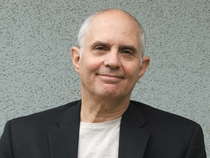 466.
Philip Goldberg (?)
is a spiritual counselor, Interfaith Minister, and author or coauthor of
numerous books, including Roadsigns on the Spiritual Path. 466.
Philip Goldberg (?)
is a spiritual counselor, Interfaith Minister, and author or coauthor of
numerous books, including Roadsigns on the Spiritual Path.
His latest work,
American Veda: From Emerson and the Beatles to Yoga and Meditation How Indian
Spirituality Changed the West.
He has
observed that:
"Most of the Hindu gurus, Yoga masters, Buddhist monks and other Asian teachers
who came to the West framed their traditions in a science-friendly way.
Emphasizing the experiential dimension of spirituality, with its demonstrable
influence on individual lives, they presented their teachings as a science of
consciousness with a theoretical component and a set of practical applications
for applying and testing those theories. Most of the teachers were educated in
both their own traditions and the Western canon; they respected science, had
actively studied it, and dialogued with Western scientists, many of whom were
inspired to study Eastern concepts for both personal and professional reasons."
"The interaction of Eastern spirituality and Western science has expanded
methods of stress reduction, treatment of chronic disease, psychotherapy and
other areas. But that is only part of the story. Hindu and Buddhist descriptions
of higher stages of consciousness have expanded psychology's understanding of
human development and inspired the formation of provocative new theories of
consciousness itself. "
"Their ancient philosophies have also influenced physicists, among them
Erwin Schrödinger,
Werner Heisenberg and
J. Robert Oppenheimer, who read from the
Bhagavad Gita
at a memorial service for
President Franklin D. Roosevelt. "
"In his landmark
TV series
Cosmos,
Carl Sagan
called Hinduism the only religion whose time-scale for the universe matches the
billions of years documented by modern science. Sagan filmed that segment in a
Hindu temple featuring a statue of the god Shiva
as the cosmic dancer, an image that now stands in the plaza of the
European
Organization for Nuclear Research in Geneva."

Lord Shiva, the cosmic dancer
-
an image that now stands
in the plaza of the European Organization for Nuclear Research in Geneva.
Hinduism the only religion whose time-scale for the universe matches the
billions of years documented by modern science.
Ages ago, the vast subcontinent of India birthed explorers and innovators who
focused on the inner realm. Those geniuses - spiritual sages or scientists of
consciousness, depending on your perspective - gave us, through a series of
modern translators and adapters, insights that have profoundly influenced
religion, healthcare, psychology, the arts and other areas of life. The way we
understand ourselves and the universe has been shaped by India more than we can
readily appreciate.
(image source:
A Tribute to
Hinduism: Thoughts and Wisdom spanning continents and time about India and her
culture - By Sushama Londhe p. 268).
***
"Western religions would do well to emulate this history. Their historical and
faith-based claims conflict with empirical science and probably always will; but
to the extent that their practices directly impact human life, they can be
treated as testable hypotheses."
"Ages ago, the vast subcontinent of India birthed
explorers and innovators who focused on the inner realm. Those geniuses -
spiritual sages or scientists of consciousness, depending on your perspective -
gave us, through a series of modern translators and adapters, insights that have
profoundly influenced religion, healthcare, psychology, the arts and other areas
of life. The way we understand ourselves and the universe has been shaped by
India more than we can readily appreciate.
"More important, India's philosophy of
Vedanta and the methodologies of
Yoga
gave the land of the free a rational, pragmatic, individuated way to conceive of
spirituality. And more important still, consider what India's ancient pluralism
- embodied in the Vedic maxim, "Truth is one, the wise call it by different
names" - offers a modern world torn by religious and ethnic tension. Half a
century ago, the great historian
Arnold Toynbee wrote that
India's spiritual
legacy offers us "the attitude and the spirit that can make it possible for the
human race to grow together into a single family -- and, in the Atomic Age, this
is the only alternative to destroying ourselves."
(source:
Are
Eastern Religions More Science-Friendly? - By Philip Goldberg -
huffingtonpost.com and
Obama should have thanked India -
By Philip Golberg - huffingtonpost.com).
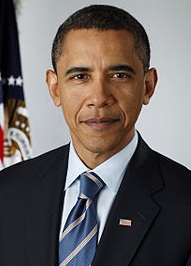 467.
President Barack Hussein Obama (1961 - )
is the 44th and current President of the United States. He is the first African
American to hold the office. In his trip to India he noted: 467.
President Barack Hussein Obama (1961 - )
is the 44th and current President of the United States. He is the first African
American to hold the office. In his trip to India he noted:
“….Indians
unlocked the intricacies of the human body and the vastness of our universe. And
it is no exaggeration to say that our information age is rooted in Indian
innovations—including the number zero. India not only opened our minds, she
expanded our moral imagination. With religious texts that still summon the
faithful to lives of dignity and discipline.”
“And we
believe that when countries and cultures put aside old habits and attitudes that
keep people apart, when we recognize our common humanity, then we can begin to
fulfill the aspirations we share. It’s a simple lesson contained in that
collection of stories which has guided Indians for centuries—the Panchtantra. And it’s the
spirit of the inscription seen by all who enter this great hall:
‘That
one is mine and the other a stranger is the concept of little minds. But to the
large-hearted, the world itself is their family.” is a translation of
a Sanskrit
subhashita:
“Ayam nija paro vedi gananam laghu chetasam
Udaara charitanam tu vasudaiva kutumbakam”.
-
Maha Upanishad,
Verse 71.
Obama made references, both explicit and oblique, to
Rabindranath Tagore and
Swami Vivekananda, and to the tales of the
Panchatantra and to a dictum from the
Bhagavad Gita.
US President said:
“Instead of succumbing to division, you have shown that the strength of India —
the very idea of India — is its embrace of all colours, castes and creeds. It’s
the diversity represented in this chamber today. It’s the richness of faiths,
celebrated by a visitor to my hometown of Chicago more than a century ago — the
renowned Swami Vivekananda. He said that,
‘holiness, purity and charity are not the exclusive possessions of any church in
the world, and that every system has produced men and women of the most exalted
character’.”
He did not attempt
the Sanskrit original “Vasudeva kutumbakam”
but everyone smiled at his reference to the Bhagavad
Gita.
He
spoke about how much Mahatma Gandhi meant to him, adding without flourish: “And
I am mindful that I might not be standing before you today, as President of the
United States, had it not been for Gandhi and the message he shared with America
and the world.”
(source: A
Global Partnership - BJP
and
Land of milk, honey and Obama prose – By Manini Chatterjee -
telegraphindia.com).
 468. Jack
Hebner (1946
-
) aka
Swami B G (Bhakti Gaurava) Narasingh
- is a Hindu monk, author,
photographer, videographer, and documentarian. He currently resides in India at
Sri Narasingha Chaitanya Matha. The books by SBGN include 'Kumbha Mela',
Vaishnava India, Gayatri-nigudhartha, Saraswata Parampara, Evolution of Theism,
and Prakrta-rasa-aranya-chedini. His numerous articles on the topics of
archaeology, history, architecture. 468. Jack
Hebner (1946
-
) aka
Swami B G (Bhakti Gaurava) Narasingh
- is a Hindu monk, author,
photographer, videographer, and documentarian. He currently resides in India at
Sri Narasingha Chaitanya Matha. The books by SBGN include 'Kumbha Mela',
Vaishnava India, Gayatri-nigudhartha, Saraswata Parampara, Evolution of Theism,
and Prakrta-rasa-aranya-chedini. His numerous articles on the topics of
archaeology, history, architecture.
He
has produced many documentaries on India highlighting Indian tradition and
culture and bringing to the fore some of the social issues and is the author of the book, Kumbha Mela in
which he has
written about the Kumbha Mela as:
" The
world's most massive act of faith."
'They
came by the millions! Some arrived on overcrowded trains carrying five times
their normal capacity. Some came by bus, by car, some by ox drawn carts, and
others rode on horses, camels, and even elephants. The rich and famous chartered
private planes and helicopters, while the less affluent came on foot carrying
their bed rolls and camping equipment in heavy bundles on their heads. Wave
after wave, they formed a veritable river of humanity that flowed onto the banks
of the Ganges at
Allahabad
to celebrate the greatest spiritual festival ever held in the history of the
world, the Kumbha Mela."
"Spiritual
and intellectual efforts of hundreds of millions of people over millennia have
graced India
with a rich and complex culture — a culture whose subtlety knows no rival.
During the last three centuries the attempts of most Westerners to penetrate the
spiritual dimension of Indian culture has at best been doomed to superficiality."
"Although
some sincere seekers of truth from outside India's borders have succeeded in
their pursuit of Indian spirituality (and this is increasing as time goes on),
still, the vast majority of the Western world remains caught in the slumber of
misconception, much of which can be traced to an insufficient fund of knowledge
and misinformation. Without the benefit of a preliminary briefing or education
in Indian spirituality, a newcomer to
India
is certainly at a decided disadvantage, and is apt to view things according to
his or her own cultural or religious biases. Of course this cultural cataract
has marred many attempts to understand another's culture, yet the British view
of
India
is perhaps one of the most vivid examples of misunderstanding that continues to
take its toll today, some 40 years after Indian independence.
Thus perhaps the
richest spiritual heritage on Earth has been relegated to obscurity in modern
times."
(source:
Kumbha
Mela - By Jack Hebner and David Osborn p. 1 - 56 and
A
British View of
India
-
Cultural
Cataracts - By Jack Hebner -
archaeologyonline.net).
 469.
Dr.
Hiro G Badlani ( ? )
practiced opthmalogy for 40 years in Mumbai, India. After retiring he moved to
the US to join his children. In his recent book,
Hinduism: Path of the
Ancient Wisdom
he notes that: 469.
Dr.
Hiro G Badlani ( ? )
practiced opthmalogy for 40 years in Mumbai, India. After retiring he moved to
the US to join his children. In his recent book,
Hinduism: Path of the
Ancient Wisdom
he notes that:
"Unlike the Western concept of linear time, the
Hindus accept time as cyclical, with neither beginning nor end. At first, the
concept of Vedic Kalpas (time units) might seem absurd, but when these figures
are compared with modern astronomical scientific data, it is amazing to notice
the patterns of similarity between the two. How could it have been possible to
discover all this without any technology, without instruments, and without any
computers? Ancient Hindu seers or Rishis, who are credited with having invented
the zero and decimal phenomenon, seem to have had a deep insight of cosmic
events, based on the fundamental principle of harmony. "
"There are billions of other galaxies of stars
like ours. Hindu scriptures have given stunning descriptions of these infinite,
countless solar systems (brahmands) in the cosmos. The galaxies have been there
from eternity. But the most surprising thing is that all these stars, their
satellites, comets, and other phenomena are positioned with a faultless
precision. The ancient Hindu Rishis studied these complex astronomical
structures minutely, giving the world authentic and deep knowledge of astronomy
and astrology. "
"Hindu Rishis stated
that there are eternal cycles of evolutions, or srshti, and dissolutions (pralaya)
taking place in the cosmos. Modern science is only now coming to grips with this
understanding of the cosmic phenomenon. The Rishis, however,
recognized this cosmic phenomenon, and they called it
Brahman - the transcendental, supreme, the eternal soul, which
pervades everything, everywhere, at all times. The world is there, and we are
there because of this source of power behind us. In fact, all our power and
intelligence is simply extended to us from this eternal source. The concept of
universal Brahman sowed the seeds of spiritual unity."
"Human beings have now started to realize how
tiny a particle of this vast infinite cosmos of the Divine they are and should
not, therefore, become arrogant about their own accomplishments and
achievements, however big they might be. The ancient Rishis also recognized
vulnerability and weakness of man. They recognized the futility of man to depend
upon his ego. They compared man to a wave of the ocean; it rises and moves
because it is with the ocean. Separated from it, the wave will perish in a
moment. They compared the man to a whiff of air, to a bubble of water, to a
speck of dust, and to a grain of sand. Again and Again they reminded mankind to
be vigilant. They reminded man to strive to remain in connection and union with
the source, the eternal God."
Hindu Rishis sang and
wrote thousands of hymns in tribute to this supreme power."
(source:
Hinduism: Path of the Ancient Wisdom - By Dr. Hiro
Badlani p. 1 - 5).
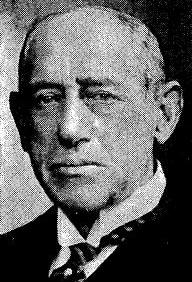 470.
Sir Sidney James Mark Low (1857–1932) journalist,
historian, and essayist and author of the book, The Governance of England and
Vision of India. He visited the Kumbh Mela during the tour of the Prince and Princess of Wales
in 1906, was wonderstruck and wrote: 470.
Sir Sidney James Mark Low (1857–1932) journalist,
historian, and essayist and author of the book, The Governance of England and
Vision of India. He visited the Kumbh Mela during the tour of the Prince and Princess of Wales
in 1906, was wonderstruck and wrote:
“Nothing
more impressive, picturesque, and pregnant with meaning and significance than
Kumbha Mela can be witnessed in all of India.”
(source:
Kumbha
Mela - By Jack Hebner and David Osborn p. 1 - 56 and
A
British View of
India
-
Cultural
Cataracts - By Jack Hebner -
archaeologyonline.net).
471.
J G Arora ( ?)
a former Chief Commissioner of Income Tax in India.
He has written about the
Bhagavad Gita:
"Bhagvad
Gita,
literally meaning the Divine Song, is a practical guide to day-to-day life. It
is meant for them who want to achieve supreme success and excellence. It is
meant also for them who wish to transcend suffering and misery. Gita helps them
also who want to live a life of contentment and divine blessedness. Because of
its theme and content, Gita has got universal appeal, and will help anyone
realise his dreams. Gita is a practical guide to day-to-day problems, challenges
and obligations of life. It takes us to real freedom and real success. Gita
stipulates that real freedom is freedom from attachment, aversion, ego, greed,
anger and fear. For Gita, real worship consists of doing one's duty with
perfection without being distracted by thoughts of outcome of our action. It
liberates us from all bondages, doubts, self-imposed limitations, anxieties and
fears, and enables us to lead happier, fuller, contented, peaceful, blissful and
supremely successful life."
"Gita's message is timeless and universal, and is
applicable to all situations, all times and all places. It cannot be confined
just to a war like situation. "
"As per Gita, we are not just
the body, the material beings. Rather, we are spiritual beings, the imperishable
Aatma. The knowledge that we are the Aatma, a part of divinity, gives the proper
direction to our life. Liberating us from our limitations, bondages,
attachments, aversions, ego, greed, anger and fears, Gita makes us lead happier,
fuller, meaningful, contented, and superbly successful life." "Besides, Gita proclaims that
combination of wisdom and valour brings glory and victory as shloka 18.78 (the
last shloka of Gita) declares: "Yatra yogeshwarah Krishno yatra Paartho
dhanurdharah,
tatra shreervijayo bhootirdhruvaa neetir matirmama." - Wherever Krishna, the
Lord of Yoga, and Arjun, the wielder of bow are there; wealth, victory and
prosperity are bound to follow. "
Speaking of
Sanskrit
as India's glory - he has said:
"Sanskrit
is the symbol, the heart and the most precious possession of Bharat. Sanskrit
has the oldest and richest literature in the world."
There is an apt adage
admiring Sanskrit: "Bhashasu mukhya madhura divya geervaan bharati"
"Among all the languages,
Sanskrit is the best, sweetest and divine language). Literally meaning "refined
and cultured", Sanskrit is the divine language revealed through the sages (Sanskritam
naam daivi vaak anavyakhyata maharshibhihi). Excepting Tirukkural which is in
Tamil, almost all ancient Hindu scriptures like Vedas, Upanishads, Ramayan,
Mahabharat are in Sanskrit." "Sanskrit is a scientific and
systematic language with a perfect grammar. It is the vast ocean of wisdom and
knowledge. Besides, it is computer compatible. Till a few centuries ago, Hindu
religion, culture and philosophy stretched from Gandhar (modern day Afghanistan)
to Indonesia. And Sanskrit language was the instrument for this glory. But
repeated Muslim invasions of Indian subcontinent destroyed many centres of
classical learning leading to decline of Sanskrit. First Mantra of Rig Veda is
the first known poem in the world. English language has just one Shakespeare.
But Sanskrit has got thousands of Shakespeares.
It is pitiable that the
so-called ‘educated’ Indian knows nothing about
them or about Sanskrit. "
"The language which has all along sustained us cannot be allowed to fade away.
Sanskrit must be revived and taught in schools and colleges since its survival
is a must for survival of Hinduism. Revival of Sanskrit will Hinduise the
self-alienated Hindus, de-colonise their mind, and impart them self-knowledge
and self-worth. Mere ritual celebration of ‘Sanskrit Day’ on Shravani Poornima
every year cannot revive Sanskrit’s lost glory. And since survival of Sanskrit
is a must for survival of Hindu religion, Hindu heritage and Hindu civilisation,
all pro-Hindu individuals and organisations must make relentless efforts to
ensure that sweet symphony of Sanskrit pervades all over Bharat once again. And
such efforts will certainly fructify as Mantra number 7.52.8 of Atharva Veda
proclaims, "Kritam may dakhshine haste, jayo may savya aahitah" (effort is in my
right hand, and victory in my left)."
(source: Bhagvad
Gita for supreme success
– By J G Arora and
Revive Sanskrit to save Hinduism - By J G Arora).
 472.
Vamsee
Juluri ( ? ) is a professor of media studies at
the University of San Francisco. He is the author of
Becoming a Global Audience: Longing and Belonging in Indian Music Television,
and The Mythologist: A Novel. 472.
Vamsee
Juluri ( ? ) is a professor of media studies at
the University of San Francisco. He is the author of
Becoming a Global Audience: Longing and Belonging in Indian Music Television,
and The Mythologist: A Novel.
He has written that:
"The
gods of Hinduism have never been up there in some cold palace playing cruel
whimsical games of fate with us humans. Instead, they have taken their place
among us. They have let us call them friend, cousin, son, mother, teacher, and
adore them as such. For it is only in relationships that we humans adore, and it
is only in adoration that we learn the lessons of the gods: to live in
friendship with ourselves and others, to attain a sense of justice in our
actions, and to surrender to serenity. That is the story about our gods, and it
is a story that has been told countless times over the millennia in words,
songs, gestures, sculpture, and art."
"..it is my belief that
the tales of the gods, like the philosophy that is infused in them, like
Hinduism as a whole, are deeper and more resilient than any constraint that our
era can put on them.
"Commercialism may have turned mythology into a media
formula, with virtually any movie being cited as a retelling of the
Ramayana and Mahabharatha; politics may have rubbed the stories of the gods the wrong way,
from Right and from Left, leaving out the greatness of heart in them altogether.
But when we look at the history of our "myths" more accurately, we will surely
find what it was about them that made them both timeless and timely for so many
generations."
(source: Mythology, Media and the future of Hinduism - By Vamsee Juluri -
huffingtonpost.com).
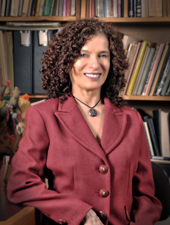 473. Susan
L Huntington
(?)
is professor in art history at Ohio State University. Among other books, she is
the author of the
Art of Ancient India.
She has written: 473. Susan
L Huntington
(?)
is professor in art history at Ohio State University. Among other books, she is
the author of the
Art of Ancient India.
She has written:
"Archaeological
finds from India give us glimpses of a culture uniquely at ease with itself."
"The word yoga means "to unite" and ancient yoga was intended to prepare the
body for meditation through which the individual would seek to understand his or
her oneness with the totality of the universe. Once this understanding was
complete, people could no more hurt another living being than themselves. Today,
such practices are routinely prescribed to complement western medical and
psychotherapy treatments. Among the documented benefits of yoga and its
corollary, meditation, are lowered blood pressure, greater mental acuity and
stress reduction. "
"To the ancients who developed and perfected these mentally and physically
challenging methods, however, yoga and meditation were tools for finding inner
peace and a harmonious existence. Once you look closely, plenty more evidence
points to the non-violent, peaceful nature of these early peoples. For example,
the archaeological remains of the cities and towns of the Indus civilisation
during its florescence from c2300-1750 BC show little of any indication of
internal dissent, criminality, or even the threat of war and conflict from the
outside. There are no known fortifications, nor is there proof of ransacking and
pillaging."
"There is also an emphasis on citizenship rather than a ruling elite in this
period. Indeed, archaeological evidence suggests there was, in fact, no
hereditary ruler - such as a king or other monarch - that amassed and controlled
the wealth of the society. Thus, in contrast to the other ancient civilisations
of the world, whose vast architectural and artistic undertakings, such as tombs
and large-scale sculptures, served the wealthy and powerful, the Indus
civilisation leaves nothing in the way of such monuments. Instead, government
programmes and financial resources seem to have been directed towards the
organisation of a society that benefited its citizens. "
"Another feature that sets the ancient Indus culture apart from other early
civilisations is the prominent role played by women. Among the artefacts we have
been able to unearth are thousands of ceramic sculptures representing women,
sometimes interpreted as goddesses, and, specifically,
mother goddesses. This is a core element in the major religious
developments of India, which are populated with goddesses - some supreme and
others whose role is to complement male deities who would otherwise be
incomplete or even powerless.
It is thus hardly surprising that the symbol
chosen for the nationalistic independence movement of the early 20th century and
the establishment of India’s modern democracy was Bharat Mata - that is,
Mother India. "
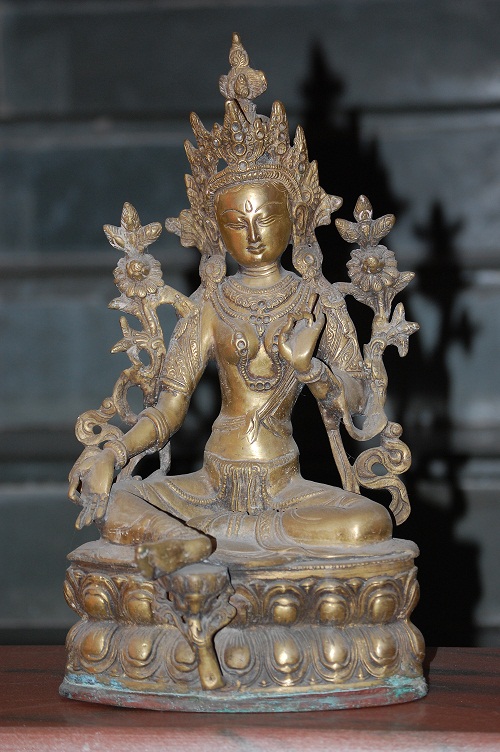
A exquisitely crafted Goddess in brass.
Another
feature that sets the ancient Indus culture apart from other early civilisations
is the prominent role played by women. Among the artefacts we have been able to
unearth are thousands of ceramic sculptures representing women, sometimes
interpreted as goddesses, and, specifically, mother goddesses.
The
cultural continuity between India’s past and present is unmatched in the other
regions of the world.
(image source:
webmaster's own collection of photos).
***
"All three of these Indic (Hinduism, Buddhism, Jainism)
religions share the belief that every living being is subject to a cycle of
birth and rebirth over countless aeons. Known as samsar,
this cycle of transmigration is not limited to humans but includes all sentient
beings. The form one will take in a future birth is determined by one’s karma -
a term that in modern parlance has come to mean little more than "luck", but the
original Indic use of the word specifically refers to one’s actions, which are
the result of choice, not chance. Although today we assign different names to
these three religious traditions, in many ways they are considered different
paths, or margas, toward a similar objective. Within Indic culture, and indeed
even within families, individuals have been free to choose their own marg, and
we have no evidence of religious conflict among these traditions. "
Unique Legacy
"As suggested by the artefacts that have survived and what we know about the
religious and philosophical beliefs of the people, the period 2500BC-AD500 in
ancient India was one of extraordinary cultural brilliance, with innovations and
traditions that still leave their mark on the world today.
Furthermore, the cultural continuity between India’s past and present is
unmatched in the other regions of the world. The modern societies in Egypt,
Mesopotamia, Greece, Rome, the Americas and China for the most part bear little
resemblance to their ancient counterparts. Ancient India’s legacy in
the fields of science and mathematics is significant. Mathematics was important
to the layout of religious buildings and the philosophical comprehension of the
cosmos. The fifth century AD astronomer and mathematician
Aryabhatta is credited
with originating the modern decimal system, which is predicated on an
understanding of the concept of zero. Evidence of the Indic origin of the idea
of zero, including the use of a small circle to denote the numeral, is found in
Sanskrit texts and inscriptions. "
"The ancient Indian principle of non-harm, and the
Indic compassion towards all living beings and the corresponding non-violent
stance has been adopted by groups that advocate vegetarianism, animal welfare
and environmental
activism.
Perhaps there is no greater compliment that can be paid to India’s ancient
culture than the fact that its sophisticated beliefs and reverence for life can
serve as guideposts to the world today."
(source:
The story of Mother India
-
By Susan Huntington - guardian.co.uk).
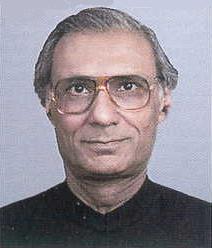 474. Arvind
Sharma
( ? ) author of the book,
Why I am a Believer, Personal Reflections on Nine
World Religions, contains nine essays by articulate believers in the Buddhist, Jaina, Sikh, Dao, Jewish, Christian, Confucian, Muslim and Hindu faiths.
He shows how
Hinduism's implicit understandings about religion are becoming key propositions
on the world stage as humanity searches for a way beyond fundamentalism to a new
world of multi-faith, religious pluralism. 474. Arvind
Sharma
( ? ) author of the book,
Why I am a Believer, Personal Reflections on Nine
World Religions, contains nine essays by articulate believers in the Buddhist, Jaina, Sikh, Dao, Jewish, Christian, Confucian, Muslim and Hindu faiths.
He shows how
Hinduism's implicit understandings about religion are becoming key propositions
on the world stage as humanity searches for a way beyond fundamentalism to a new
world of multi-faith, religious pluralism.
"Hinduism has three alluring dimensions that make me want to be a Hindu:
subtlety, charity and civilizational creativity."
"The goal of Hinduism is to convert an empty mind into an open mind.
This is a
delicate endeavor; how delicate may be seen in the West's attempt to do this in
the form of the New Age movement. The mind tends to become so open, according to
observers, that the brain almost falls out." "I
think Hinduism searches for the ultimate in metaphysics and for the universal in
morality, in comparison to the West, which concludes only too often that it has
found the ultimate in metaphysics, even as it formulates the absolute in
morality. "
"The
West displays a tendency in the moral realm to speak in absolutes.
An
absolute is fixed; it allows of no exceptions. Stated in a positive way, one
could say that an absolute is certain and firm; stated in a negative way, one
could say that it is static and rigid. On the other hand, a universal is
consensual and fluid. Stated in a positive way, one could say that it is
broad-based and dynamic; stated in a negative way, one could say that it is
wishy-washy and unsteady. The differences between the two lie in their
orientation--one works from top down, the other from bottom up. I think Hinduism
is better off for implicitly distinguishing between final and ultimate, and
between absolute and universal, and in further distinguishing between the goals
of metaphysics and morality."
"A third distinction implicit in Hinduism is one between single-mindedness and
narrow-mindedness. Sometimes other religions, in trying to become single-minded,
become narrow-minded, as in certain understandings of jihad in the context of
terrorism, and of the Christian mission in the context of
proselytization.
I think the Hindu world has largely escaped this
predicament, at least so far, because Hinduism is a religion which has its
center everywhere and its circumference nowhere, in the sense that the doctrine
of the ishtadevata (or the chosen Deity) within it allows each Hindu to be a
center of his or her own universe or to be single-minded in his or her devotion
without being judgmental about others.
Alternatively, Hinduism can be
said to have its circumference everywhere and its center nowhere. However, we
might wish to split the metaphor. By disconnecting the center from the
circumference, it has ensured that being single-minded does not lead to
narrow-mindedness in relation to another. "
(source:
Why I Am a Believer: a Hindu's Answer - By Dr. Arvind Sharma -
hinduismtoday.com).
 475.
Josh
Schrei
(?) is a
Marketing Director, Strategist, Producer, Writer, Critic, Activist. 475.
Josh
Schrei
(?) is a
Marketing Director, Strategist, Producer, Writer, Critic, Activist.
He has written most eloquently about Hinduism's open source and staggering
contribution to the our spiritual world:
"The
sheer volume of spiritual literature and doctrine, the number of distinct gods
worshiped (over 30 million, according to some sources), the breadth of distinct
philosophies and practices that have emerged, and the total transformation over
time of many of the core Indic teachings and beliefs can be disconcerting to
those raised in monotheistic cultures, as we are used to each faith bringing
with it a defined set of beliefs that -- with the exception of some
denominational rifts over the centuries -- stay pretty much consistent over
time."
"However,
the key point of differentiation between Hinduism and these other faiths is not
polytheism vs. monotheism. The key differentiation is that "Hinduism" is Open
Source and most other faiths are Closed Source."
"If
we consider god, the concept of god, the practices that lead one to god, and the
ideas, thoughts and philosophies around the nature of the human mind the source
code, then India has been the place where the doors have been thrown wide open
and the coders have been given free reign to craft, invent, reinvent, refine,
imagine, and re-imagine to the point that literally every variety of the
spiritual and cognitive experience has been explored, celebrated, and
documented. Atheists and goddess worshipers, heretics who've sought god through
booze, sex, and meat, ash covered hermits, dualists and non-dualists, nihilists
and hedonists, poets and singers, students and saints, children and outcasts ...
all have contributed their lines of code to the Hindu string.
The results of India's God Project - as I
like to refer to
Hinduism --
have been absolutely staggering.
"The body of knowledge
-- scientific, faith-based, and experience-based -- that has been accrued on the
nature of mind, consciousness, and human behavior, and the number of practical
methods that have been specifically identified to work with ones own mind are
without compare. The Sanskrit language itself contains a massive lexicon of
words -- far more than any other historic or modern language -- that deal
specifically with states of mental cognition, perception, awareness, and
behavioral psychology."
"At the heart of the Indic source code are the Vedas, which immediately establish
the primacy of inquiry in Indic thought. In the Rig Veda, the oldest of all
Hindu texts (and possibly the oldest of all spiritual texts on the planet), God,
or Prajapati, is summarized as one big mysterious question and we the people are
basically invited to answer it."
"Who really knows?
Who
will here proclaim it?
Whence
was it produced?
Whence
is this creation?
The
gods came afterwards, with the creation of this universe.
Who
then knows whence it has arisen?"
While the god of the Old Testament was shouting command(ment)s, Prajapati was
asking: "Who am I?"
"Since opening the floodgates on the divine question, Indic thought has followed
a glorious evolutionary arc from shamanism, nature worship and sacrifice through
sublime and complex theories on mental cognition, the nature of consciousness,
and quantum physics. Through tracing the subcontinents relationship with the
deities of the Vedas, we can trace the course of Indic thought over the
centuries. One of the first things we notice is that not only does the people's
relationship to god change over the centuries, the gods themselves change.
Shiva, for example, appears in the Vedas as Rudra, the howler, god of storms,
still something of a lesser deity. Reappearing over the centuries as Bhairava --
he who inspires fear -- Pashupati, lord of beasts, the god of yogis, and the
destroyer, Shiva finally, by the 9th century, achieves status in Kashmir as the
fundamental energetic building block of the entire universe. Neat trick. But as
much as the gods change and the evolution of Indic thought leads us to
increasingly modern and post-modern views of the nature of reality, the old
Vedic codes still remain front and center. One of Hinduism's defining factors is
that the historic view of god, the nature worship and shamanism, never went
away, so that god as currently worshiped exists simultaneously as symbol and
archetype as well as literal embodiment. That Shiva, for instance, could
simultaneously be the light of ultimate consciousness and an ash-smeared madman
who frequents cremation grounds is a delight to us spiritual anarchists,
while
mind numbing to most western Theologists."
"Western and Middle Eastern monotheistic faiths have simply not allowed such
liberal interpretation of their God. They continue to exist as closed source
systems."
"Generally, [closed source] means only the binaries of a computer program are
distributed and the license provides no access to the program's source code. The
source code of such programs might be regarded as a trade secret of the
company." One of the defining facts of Christian history is that access to God
has been viewed -- as in most closed source systems - as a trade secret. The
ability to reinterpret the bible, or the teachings of Christ, or the Old
Testament, or to challenge the basic fundamental authority of the church has
been nonexistent for most of the church's history.
Those who dared to do so were quite often killed.
In Indic thought, there is no trade secret. The foundation of
yoga is that the
key to god, or the macrocosm, or the absolute ... lies within the individual and
can be accessed through a certain set of practices. It's a beautifully simple
but ultimately profound concept that has been allowed to flourish unchecked for
millennia. The process of discovering and re-imagining the divine is in your
hands. The God Project."
"Any
two-bit religious scholar knows that Buddhists and Hindus count time in
kalpas, or segments of millions of years,
and that they firmly believe the earth was created billions of years ago. There
are many prominent Hindu scholars, in fact, who posit that some of the best
loved Hindu legends from the Mahabharata and the Ramayana are in fact tales from
Neanderthal times."
"Indian
history, for example, contains a vast body of
incredibly sophisticated scientific/academic literature on god,
concepts of god, consciousness at it relates to god, the human body and human
thoughts and emotions in relation to god… and, in the case of Kashmiri Shaivism for example, quantum
physics as it relates to god. The concept of spanda in
Kashmiri cosmology is one of the most intellectually complex and sophisticated
views on divinity ever put forth. Abhinavagupta
— the brilliant architect of much of Indian thought– penned theistic texts over
1,000 years ago that contain scientific truths that physicists are just now
confirming."
(source:
The God Project: Hinduism as Open-Source Faith - By Josh Schrei -
huffingtonpost.com
and
Christopher Hitchens is absurd - By Josh Schreiy).
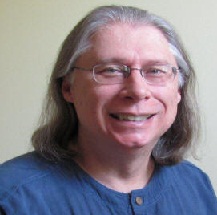 476.
Yogi Baba Prem
( ? ) who is a Hindu Yogi, a Vedavisharada trained in the traditional
Gurukural system. 476.
Yogi Baba Prem
( ? ) who is a Hindu Yogi, a Vedavisharada trained in the traditional
Gurukural system.
He has spiritedly defended
Yoga's Hindu
roots and has expressed his views thus:
"there is no Christian Yoga. "Yoga is not a Judeo/Christian word!
It is not a part of the Roman Catholic teachings and certainly
not a part of protestant teachings. It is not found within the King James
Version of the bible."
"It is a Hindu word, or more correctly a
Sanskrit word
from the Vedic civilization."
Modern day scholars from India frequently present
the attitude of “let them have yoga, I am interested in protecting Hinduism.” I
have heard this sentiment on numerous occasions, but the reality is that yoga is
a part of Hinduism. Allowing one part to be taken from Hinduism opens a door for
the distortion of the teachings. We must
remember that the roots to modern day yoga comes from
Vedic Yoga.
The same Vedic Yoga that is the
authority of Hinduism.
Allowing one branch to be severed from the tree of knowledge will not
necessarily kill that tree, but it can produce strain and have an unbalancing
effect upon the tree.
"Hinduism should reclaim its full
heritage and not allow other groups to rename its sacred teachings under their
banner, especially when they have no history of those teaching within their own
system. If they wish to ‘borrow’ and say this comes from our
brothers and sisters in Hinduism, then that is another thing. But frequently
groups attempt to privatize the information and present themselves as the
original authority. Hinduism should guard against its sacred traditions
becoming distorted and taken away."
"Scholars at universities should
take the stand that yoga is part of Hinduism, though one is one required to be a
Hindu to practice yoga. It is important to acknowledge the roots of the
tradition; after all we are expected to give credit to the original sources
within books and research papers, but yet Hindu scholars have ignored this
fundamental western view when it comes to their own heritage."
(source:
A Hindu Yogi Speaks: "There is no Christian Yoga").
"Aum
is one of the sacred sounds (pranava) in the great Indian tradition. But AUM is
a sound, word, and symbol that has permeated western culture more extensively
than almost any other aspect of the Indian tradition. Originally AUM was a
sound that was reserved for Brahmins and students of the Vedic system. It was
most commonly taught to Brahmins (priests), scholars, philosophers, and
religious leaders. It is in common usage amongst Brahmins and Vedantists. To
them it is considered a sacred sound called pranava. Literally the word pranava
means, “humming”. Pranava can be a reference to a boat that carries us across
the ocean of birth and reincarnation. It can also mean to “roar”, sound, or
reverberate. The word pranava comes from the Sanskrit root “nu”, which means to
praise. So AUM is literally a humming sound of praise, which aids to carry us
across the ocean of transmigration or reincarnation. Is it the only pranava
sound? No, it is considered the highest, but there are several pranava sounds
that exist within different systems in India."
(source:
The significance of Aum - By Yogi
Baba Prem).
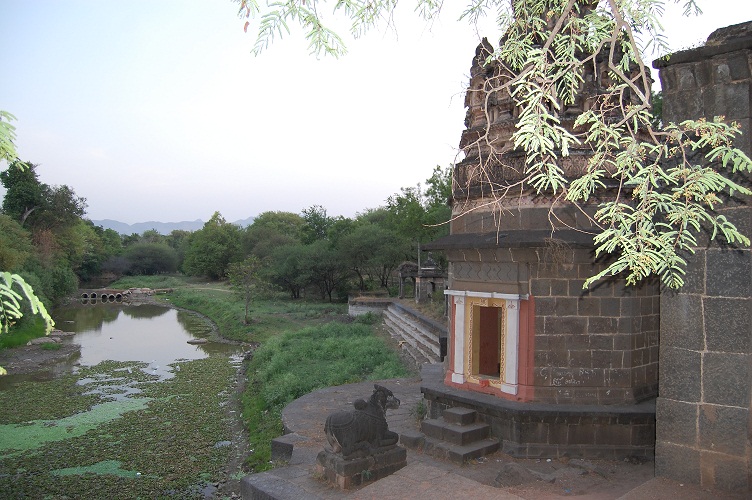
Lovely aerial view of Shri.ChangaWateshwar Temple
in Saswad, Maharashtra at the confluence of two rivers Karhe and Chambli.
Hidden amidst the effervescent Sahyadri
mountain ranges, the temple is a jewel of an abode of peace from the past.
(image source:
webmaster's own collection of photos taken during a recent visit).
***
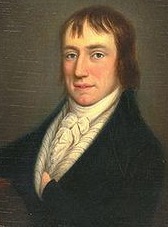 477.
William Wordsworth
(1770 - 1850)
was a major English Romantic poet who, with Samuel Taylor Coleridge, helped to
launch the Romantic Age in English literature with the 1798 joint publication
Lyrical Ballads. 477.
William Wordsworth
(1770 - 1850)
was a major English Romantic poet who, with Samuel Taylor Coleridge, helped to
launch the Romantic Age in English literature with the 1798 joint publication
Lyrical Ballads.
When Wordsworth penned one of his most famous poems, 'Immortality
Ode', it seems the English Romantic poet was under
the spell of Hindu religion and its philosophy of
rebirth. Afraid that the numerous passages of the poem would
antagonise the Orthodox Christians in England, Wordsworth deleted them from the
original text, according to a new book on Hindu
philosophy and the English Romantic movement.
Nevertheless, the poem has remained ''inveterately
Hindu'', subscribing to the Hindu doctrine
of the soul's various births and deaths, says Krishna Gopal
Srivastava, the author of 'Bhagavad-Gita and the English Romantic Movement'.
Wordsworth, is not the only English poet whose works had been influenced by the
Gita. His contemporary
William Blake shared the same
belief of a long chain of births and rebirths before the soul achieved
salvation.
Samuel Taylor Coleridge, Wordsworth's bosom
friend, and the other Romantic poets -
Robert Southey,
Percy Shelley and
John Keats – too were fascinated by
Indian mysticism enshrined in the Gita,
whose rendering of Keats's 'Ode to a Nightingale' is displayed in the reading
room of the Oriental section of the Cambridge University Library.
The source of influence of the Hindu philosophy on the Romantic poets was a
revolutionary English prose rendering of the Gita by Charles Wilkins, a clerk in
the Bengal establishment of the East India Company. Wilkins translated the Gita
into English in 1785 at the recommendation of Warren Hastings, the first
Governor General of British India. The translation received an enthusiastic
response in England and two prominent magazines - The British Critic and The
Monthly Magazine -published favourable reviews on the Englishman's work. The
bases proof of the influence on Wordsworth on lines 2-4 of stanza V of the poem.
''The soul that rises with us, our life's star/Hath had elsewhere its
setting/And cometh from afar."
''It is clear that the 'Immortality Ode' - Ode: Intimations of Immortality from
Recollections of Early Childhood - is a Hindu poem,
through and through, saturated with Hindu philosophy and mythology."
Blake,
whose poem 'A Vision of the Last Judgement' was influenced by the Gita, was so
impressed by Wilkins's translation that he made a drawing of the translator
entitling it 'The Brahmin'
"....then, as the Hindoos draw
Their Holy Ganges from a skiey fount,
Even so to deduce the stream of human life
From seats of power divine; and hope ...
That our existence winds her stately course
Beneath the Sun, like Ganges, to make part
Of a living Ocean."
(source:
The Excursion - By William Wordsworth
and
Hindu philosophy and the English Romantic movement - By
Krishna Gopal Srivastava).
478.
Dr.
Aseem Shukla ( ? ) is an
associate professor in urologic surgery at the University of Minnesota Medical
School. He is also a co-founder and board member of the
Hindu American Foundation.
He also writes a weblog for The Washington Post on Hinduism-related
topics. He participated in a debate with Deepak Chopra on the topic of the
Hindu
roots of yoga.
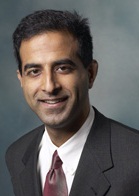 He has expressed his views on Hinduism thus: He has expressed his views on Hinduism thus:
"To a Hindu, God--that omnipotent, omnipresent and immanent Presence in the
universe--so transcends mere mortal minds, that limiting the Divine to a mere
reflection of humanity actually reflects the banality of our own minds."
"Indeed, God is visualized and worshiped in human form by Hindus, but that
reflects the dual reality of God--Nirguna
(formless) and
Saguna
(with form). A Hindu may visualize the Divine, or
Brahman, as the
formless, vast ocean. But some water from that ocean can be frozen and
visualized into any form that we wish. That same image, melted again merges once
more into that ocean of
Brahman.
Similarly,
Brahman
is contemplated as a ubiquitous potential energy, that when converted to kinetic
energy--prakriti--turns
the wheels of the universe."
"The Divine, enveloped as the
atma,
or soul, permeates every sentient being in the universe, though the entire
universe, including the non-sentient--reflect God. But here the dichotomy: Human
beings possessing mind and intellect, possess free choice, and represent the
highest evolution of life. In that, they enjoy privileged status and immense
responsibility to complete their path towards salvation. Mortals may not be the
only image of God, but certainly the most evolved."
"Simply put,
God is beyond the laughable polemics of insisting on the primacy of my
interpretation."
(source: God
is Beyond Image--Diocese is Beyond Restrictions - By Dr. Aseem Shukla -
thewashingtonpost.com).
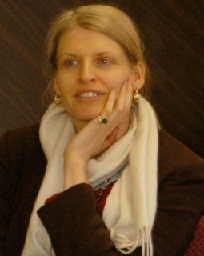 479.
Loriliai Biernacki ( ? ) is Associate Professor of
Religious Studies at the University of Colorado in Boulder. She teaches and
researches the religious traditions of India, especially Hinduism, Tantra, and
the 11th-century Indian philosopher Abhinavagupta. 479.
Loriliai Biernacki ( ? ) is Associate Professor of
Religious Studies at the University of Colorado in Boulder. She teaches and
researches the religious traditions of India, especially Hinduism, Tantra, and
the 11th-century Indian philosopher Abhinavagupta.
She has expressed
her ideas about Hinduism thus:
"Yoga
is becoming increasingly a worldwide practice, no doubt particularized by a
variety of modifications, as Raja Yoga, the Bihar School of Yoga, Iyengar yoga,
Astanga yoga, with Indian-American cross-overs like Bikram's "hot yoga," and
again, with more hybridized American variations such as Forrest Yoga, TriYoga,
and Anusara Yoga.
The roots of yoga are clearly Hindu,
yet as it makes its way across the globe, its roots are obscured. It is becoming
a pan-global phenomenon."
"Likewise, Hinduism's philosophical underpinnings -- the ideas of karma and
rebirth, notably -- are increasingly pervading American consciousness, and this
spread of ideas will increase in the future. This conceptual, indeed
cosmological, importation from Hinduism is seeping indelibly into the American
psyche. Even a percentage of self-identified Christians have little difficulty
incorporating this Hindu notion. Similarly, the word and concept of "karma" is
so commonly parlayed in everyday conversation that its Hindu origins no longer
even register, as the concept finds its way across wide ranges of socio-economic
circles and in all sorts of milieus."
"In
some sense, the trace of Hinduism as it moves across the globe in the future is
as a kind of meme, a conceptual and evolutionary hypothesis. As such, it
proposes a restructuring of our old habits of thought.
It functions as a representative of what the West with its
Cartesian mastery of the
world lacks. As meme, this spread of Hindu conceptual tenets augurs a
more healing and soulful alternative to the mechanization of our lives, our
bodies, our minds. It promises a relief from the heavy
burden of a soulless capitalism,
to what we find in classical
Hindu philosophical texts
described as the "Law of Fishes" (matsya nyaya),
a cutthroat and unsatisfied material competition in the world."
"Besides this,
Hinduism as de-nominalized meme of our future is a prelude to a future that
Hinduism is already comfortable with. Our own increasingly plural world might
take some solace, find a steady ease in the Hindu comfort with the multiple --
multiple Gods, multiple practices, and simultaneous multiple ontological
structures of monotheisms, monisms, polytheisms, and panentheisms. In this
sense, the future of Hinduism suggests a kind of opening to a global world in a
way that sidesteps the vision of a one-world government or one-world ideology.
It proposes instead a world model without hegemonic center, linked by a thread
of cosmology, multiplicity instanced as network, a seamless interconnectivity
that echoes a conceptual cosmology from Hinduism's past into our own global and
glocal future."
(source:
A rich and strange metamorphosis: Glocal Hinduism - By Loriliai Biernacki).
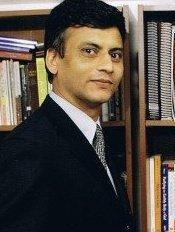 480.
Dr. Pankaj Jain
( ? )
is an Assistant
Professor of South Asian Religions and Ecology at the University of North Texas.
He has taught Indian Films, Sanskrit, Hindi/Urdu languages, and literatures at
North Carolina State University, Rutgers, Kean University, Jersey City
University, and the University of Iowa. In his scholarship he connects the
ancient Indic traditions of Hinduism and Jainism with contemporary issues -
particularly the environment. 480.
Dr. Pankaj Jain
( ? )
is an Assistant
Professor of South Asian Religions and Ecology at the University of North Texas.
He has taught Indian Films, Sanskrit, Hindi/Urdu languages, and literatures at
North Carolina State University, Rutgers, Kean University, Jersey City
University, and the University of Iowa. In his scholarship he connects the
ancient Indic traditions of Hinduism and Jainism with contemporary issues -
particularly the environment.
"Hinduism
contains numerous references to the worship of the divine in nature in its
Vedas, Upanishads, Puranas, Sutras, and its other sacred texts. Millions of
Hindus recite Sanskrit mantras daily to revere their rivers, mountains, trees,
animals, and the earth.
Although the
Chipko (tree-hugging) Movement is the most
widely known example of Hindu environmental leadership, there are examples of
Hindu action for the environment that are centuries old."
"Hinduism is a remarkably diverse religious and cultural phenomenon, with many
local and regional manifestations. Within this universe of beliefs, several
important themes emerge. The diverse theologies of Hinduism suggest that:
The earth can be seen as a manifestation of the goddess, and must be treated
with respect. The five elements - space, air, fire, water, and earth - are the
foundation of an interconnected web of life. Dharma - often translated as “duty”
- can be reinterpreted to include our responsibility to care for the earth.
Simple living is a model for the development of sustainable economies. Our
treatment of nature directly affects our karma. "
Pancha Mahabhutas
(The five great elements) create a web of life that is shown forth in the
structure and interconnectedness of the cosmos and the human body. Hinduism
teaches that the five great elements (space, air, fire, water, and earth) that
constitute the environment are all derived from prakriti, the primal
energy.
Hinduism recognizes that the human body is composed of and related to these five
elements, and connects each of the elements to one of the five senses. The
human nose is related to earth, tongue to water, eyes to fire, skin to air, and
ears to space. This bond between our senses and the elements is the foundation
of our human relationship with the natural world. For Hinduism, nature and the
environment are not outside us, not alien or hostile to us. They are an
inseparable part of our existence, and they constitute our very bodies."
(source:
Ten key Hindu Environmental teachings - By Dr. Pankaj
Jain).
Top of Page
Show
in alphabetical order



Page < 1 2 3 4 5 6 7 8 9 10 11 12 13 14 15 16 17 18 19 20 21 22 23 24 >
|